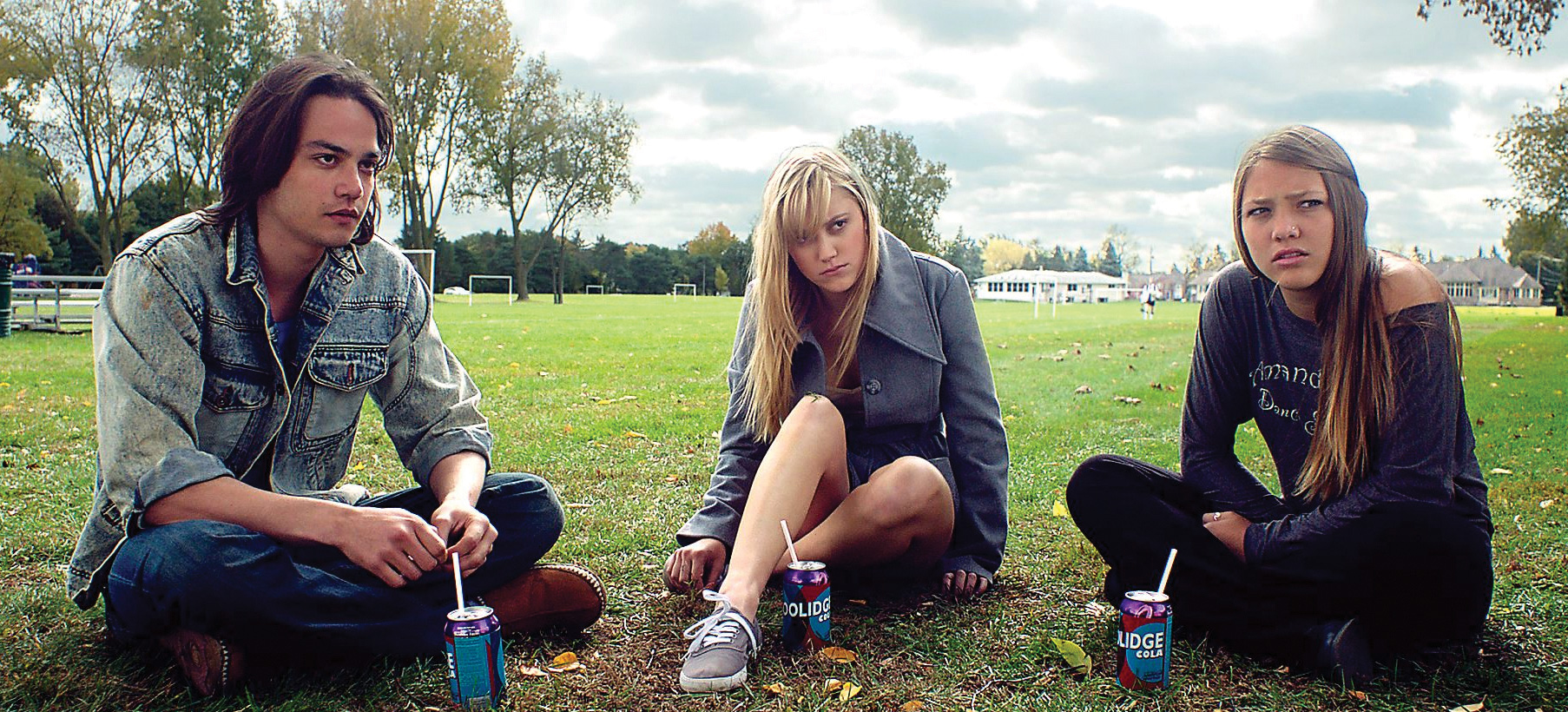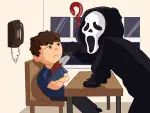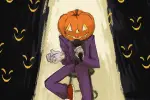It’s a dark and stormy night. The sexually promiscuous girl sits alone in her gazillion bedroom house. She’s painting her nails, texting her BFF. She hears a noise that prompts her to call out and ask if anyone’s there. No response. Another noise starts to freak her out. She does the only logical thing and ignores it and calls the police goes to investigate. She slowly creeps down the hallway, calling out that if this is some kind of joke it isn’t funny. The creepy background music starts to swell around her as she reaches the room where she believes the sound originated. Her breathing becomes erratic and right when the music hits it frantic peak, she pushes open the door to reveal…nothing.
The music stops. The girl shakes her head, smiling to herself and whispering how she’s being silly. She turns and out of the darkness behind her pops a monster/zombie/demon/crazed masked man/ghost that snatches her up and drags her away. Cue opening credits. This scene is the basic setup for almost any horror movie. There are variations and deviations here and there, but they like to stay in this bubble. It’s a structure that yields positive results, but the biggest problem with it lies in audience awareness.
Modern audiences grew up with this setup and know everything about it. They know that the character will go and investigate the strange noise. They know when it’s a fake scare (oh it was just a cat!) as opposed to a real scare (oh it was just an undead, flesh-eating space alien!). They know the big scare never comes when the background music blasts the loudest, but rather after the music stops and the character foolishly starts to let his or her guard down.
Audiences, especially college students, have learned to anticipate everything that happens because of Hollywood’s tendency to stick with known formulas. To provide a better cinematic experience for college students who scoff at all the clichés and roll their eyes at worn-out tropes, Hollywood needs to invest in ideas that bring originality to the horror genre.
All it takes is one game-changing movie to give the genre a jolt, but the problem is that Hollywood takes these fresh ideas and bludgeons them into an unappealing pulp. The best example of this is “Paranormal Activity” and the rise of the Found Footage Format in 2007.
Nowadays, the Found Footage Format is overused and unoriginal, but ten years ago it reinvigorated the genre and brought something interesting to the table. The scariest thing about those early Found Footage films was that they hit close to home. They conveyed a sense of authenticity that really hadn’t been explored since “The Blair Witch Project” in the late nineties. Both movies were heralded as revolutionary at the time of their release, but a lot of horror movies don’t stand the test of time. If they were released today, “The Blair Witch Project” would look like three people stumbling around in the woods for an hour and twenty minutes, and “Paranormal Activity” would be criticized for the lack of legitimate scares.
Audiences grow numb after seeing the same thing over and over again, which forces Hollywood to continually raise the stakes. With the Found Footage Format, studio executives are still trying to keep it relevant. This month brings the final installment (hopefully) of the Paranormal Activity franchise to theaters, but this time, it’s in 3D.
Remember how the first “Paranormal Activity” tried really hard to underscore that it was legitimately found footage by not having opening or ending credits, and taking the time to thank the families involved for letting producers show it in theaters? Those days are long gone, replaced by louder and fancier gimmicks (like 3D) in order to top what came before, because studios work under the impression that bigger is always better when having a sequel. They don’t understand that by going bigger, horror movies often lose that special factor that made the original relevant in the first place.
The problem stems from film studios’ desire to make maximum profit. When the Found Footage craze started to heat up, studios felt it benefitted everyone. Those types of movies remain cheap to make (the first “Paranormal Activity” cost only $11,000) and people flocked to the theaters to see them. Now, as the craze dies, studios still churn Found Footage movies out like clockwork, not really caring if a lot of people see them because it only takes a small audience to make it profitable. Unless a really radical new approach to Found Footage suddenly pops up (which doesn’t seem likely: the last big thing was possibly making the new “Friday the 13th“ a Found Footage film, but thankfully that fell through when they realized it’s a dumb idea), something new needs to take its place.
The horror genre has always ebbed and flowed as new concepts are introduced, stick and become popular. Before “Paranormal Activity” and the Found Footage craze, “Scream” slashed its way onto the scene, which launched the era of self-aware, tongue-in-cheek horror movies that college kids can relate to the most. This college generation feels like they are in on the joke when it comes to horror movies, and it’s amusing when the characters in the movies also seem to know what’s going on.
Modern filmmakers grew up watching all the classic scary films that laid the foundation for modern-day horror, so they know all the clichés. Unfortunately, a finite number of ways to set up a jump-scare exist, forcing filmmakers to infuse a sense of self-awareness into their movies to compensate for the lack of originality. Although the self-aware genre started off well, it quickly devolved into horror-comedy instead of self-aware horror. There’s a delicate balance between characters realizing they’re living out a horror movie script and having the movie dissolve into a parody of itself.
As time passed, it became more and more difficult for filmmakers to create a legitimate horror movie with self-aware characters. Point being: horror movies have to constantly reinvent themselves to stay fresh, which means studios need to constantly be looking for the next big thing for horror movies. If not, they get stuck treading water and rehashing old ideas. The most important factor in any horror movie is creativity, an element that a majority of mainstream, commercial horror movies fail to utilize. Right now, the indie film circuit is experiencing a type of horror movie renaissance, offering college students an array of fresh and original low-budget horror films.
Let’s make something clear. This is not going to turn into a snobbish rant condemning mainstream films and praising artsy independent features. This is making the case for why independent films can oftentimes make for better horror films than their mainstream counterparts.
Smaller films have smaller budgets (duh), so the directors of these films have to find ways to crank the creep factor and tension way up. Popular mainstream horror films like “The Conjuring” and the “Insidious” franchise are scary, but are made in a way designed to move audiences along from one jump-scare to the next. Independent films have to be conservative with their money, so they have to make audiences afraid of what they don’t see. For example, take the recent independent film “It Follows.” The movie premiered at the Cannes Film Festival in 2014 and was widely released in the United States a year later, where it was showered with critical acclaim. It was unique, creative, visually frightening and successfully ramped up the feeling of dread throughout the movie, even when the creature lurked off-screen.
The movie also worked as a legitimately scary film because it dealt with themes relevant to young audiences. While it was a movie about a monster that never stops walking toward you, the entire thing acts a metaphor for sexual awakening. Mainstream horror films can make you jump and spill your popcorn on the person in front of you, but the really terrifying movies stick with you because you relate to them on a personal level. The scary movies that deal with issues like cyber bullying or transitioning to adulthood strike an emotional chord and freak you out. Filmmakers have to tap into these kinds of themes in order to really scare our desensitized generation.
Action movies will always culminate in helicopter explosions and cheesy one-liners, romantic movies will always end with a version of the mad dash to the airport and a grand romantic gesture, but horror constantly changes. What scares audiences now won’t scare them in five years. Studios that understand this can produce films ahead of the curve, meaning they make films that successfully resonate with younger, college-aged students who know all the tired tricks that come with a stereotypical horror movie. Studios that don’t get that college students need originality will continue to pump out generic, sloppy horror films. That might be the scariest thought of all.

















